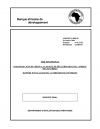Evaluation Team
This report was prepared by Mrs. G. HALL-YIRGA, Principal Evaluation Officer, Operations Evaluation
Department, (OPEV) and Mr. Akinola AKINTUNDE (Consultant), following a field mission to East Africa. Any
further matters relating to the report may be referred to Mr. D. A. BARNETT, Acting Director, OPEV or to Mrs. HALL-YIRGA
Objective
LOC V was extended at a time when major economic reforms were taking place in the member states. This evaluation found that, in general, LOC V has been relevant and in line with ADB and EAC member countries’ policies for private sector development. The LOC had achieved the main objective of providing foreign currency resources for financing private sector export-oriented and import substitution projects. However, the development outcomes have not been achieved fully
Main Findings
- LOC V was extended to EADB during the period of the structural adjustment programmes. The resultant economic liberalisation culminated in a high demand for project financing in the sub-region. This LOC, therefore, assisted EADB to meet part of this demand.
- EADB’s earlier poor governance, the weak selection and design of the sub-projects, the inadequate enabling environment for private sector development, the lack of adequate quity and working capital, the significant number of non-performing sub-projects, have compromised the achievement of LOC V objectives and outcomes. The performing sub-projects (58%) financed under the LOC were medium- and large-scale enterprises, which have provided direct and indirect employment as well as foreign exchange earnings. EADB has managed to recoup a significant portion of its funds from the failed sub-projects. EADB has consistently respected its repayment obligations to ADB.
- The enthusiasm to go for more new sub-projects (all the failed ones were new) did not bring fruit since such projects needed not only term loans but also much broader assistance encompassing working capital, entrepreneurship, infrastructure, marketing, etc. Future LOCs need to distinguish the needs of on-going concerns and new projects, particularly indigenous ones, to provide an appropriate and complete package of assistance. Although over the years, governments have improved the enabling environment for private sector development, there is a need for greater commitment and appropriate policies to cater to the needs of the private sector particularly the small and micro-enterprises.
Main Lessons
- Good governance has been a key ingredient to improve EADB’s performance following the 2003 reforms, though sustainability is still a challenge. Also of concern is EADB’s lack of an adequate monitoring system that captures the developmental outcomes of sub-projects.
- Financial sector liberalization and the ensuing availability of foreign currency in the formal markets has encouraged commercial banks to venture into medium to long-term lending – a move that poses new competitive challenges to DFIs, such as EADB. On the other side of the scale, DFIs are not adequately structured and resourced to meet the needs of small and micro-enterprises. And while institutions, such as small enterprise development agencies and NGOs, can provide technical assistance to small and micro-enterprises, their operations are often hampered by financial limitations.
- The upper limit set on sub-regional development banks, such as EADB, to finance a specific sub-project may have constrained EADB from taking up larger scale national and sub-regional projects.
Main Recommendations
Recommendation(s) to the Bank:
- In future interventions, ADB needs to assess critically that the corporate culture of DFIs have embraced good governance and best business practices.
- In addition, ADB needs to review that the monitoring and reporting system in place captures information and data on the development outcomes of the LOCs.
- In the light of LOC V’s poor performance and given that the Bank has financed two further LOCs (VI and VII) consideration of any new interventions should be subject to preparation of project completion reports on both operations.
- The application of variable interest rates in recent years is encouraging, and this should continue with efficient system to make timely adjustments resulting from changes in market rates.
- ADB should consider financing in local currency to DFIs (through co-financing with commercial banks or issuing guarantees) to raise local currency resources for on lending to SMEs. In addition, the possibility of swapping foreign currency and local currency loans should be explored to mitigate for exchange risks.
- ADB should forge effective linkages with sub-regional DFIs, and for the latter to do the same with national level financial intermediaries to channel bulk financial resources for on lending to the different client segments. Sub-regional DFIs, such as EADB, may need to concentrate on higher-level services, including those with subregional scope.
- ADB should forge partnership and establish appropriate linkages for providing funding to small enterprises development agencies and NGOs that can effectively assist in capacity development of micro and small enterprises, in areas such as business plan development, loan application procedures and processes, accounting practices, and financial reporting.
- In effect, there is a need for ADB to revisit its policies and strategies of financial intermediations through sub-regional and national DFIs to determine the respective niche for competitiveness, additionality and complementarity among the different players.
- In the interest of EADB’s future, ADB needs to dialogue with member states to enhance their share capital in order to improve EADB’s creditworthiness and, thereby, strengthen its capacity to mobilize internal and external resources.
- ADB may consider raising the existing upper limit to performing sub-regional DFIs to enable them to take up larger national-level individual projects and co-finance investments with a regional integration scope.
- As part of the governance issue, ADB needs to assist member states to have well functioning tax authorities and regulatory bodies to oversee the performance of the private sector.
- ADB’s future interventions should include conditions requiring EADB to ensure that sub-projects financed under its LOC submit audited financial accounts prepared based on accepted financial accounting principles and practices.
- ADB needs to dialogue effectively with member states to explore ways of improving the overall enabling environment including the sustained provision of basic infrastructure.
| Attachment | Size |
|---|---|
| 378.08 KB |


